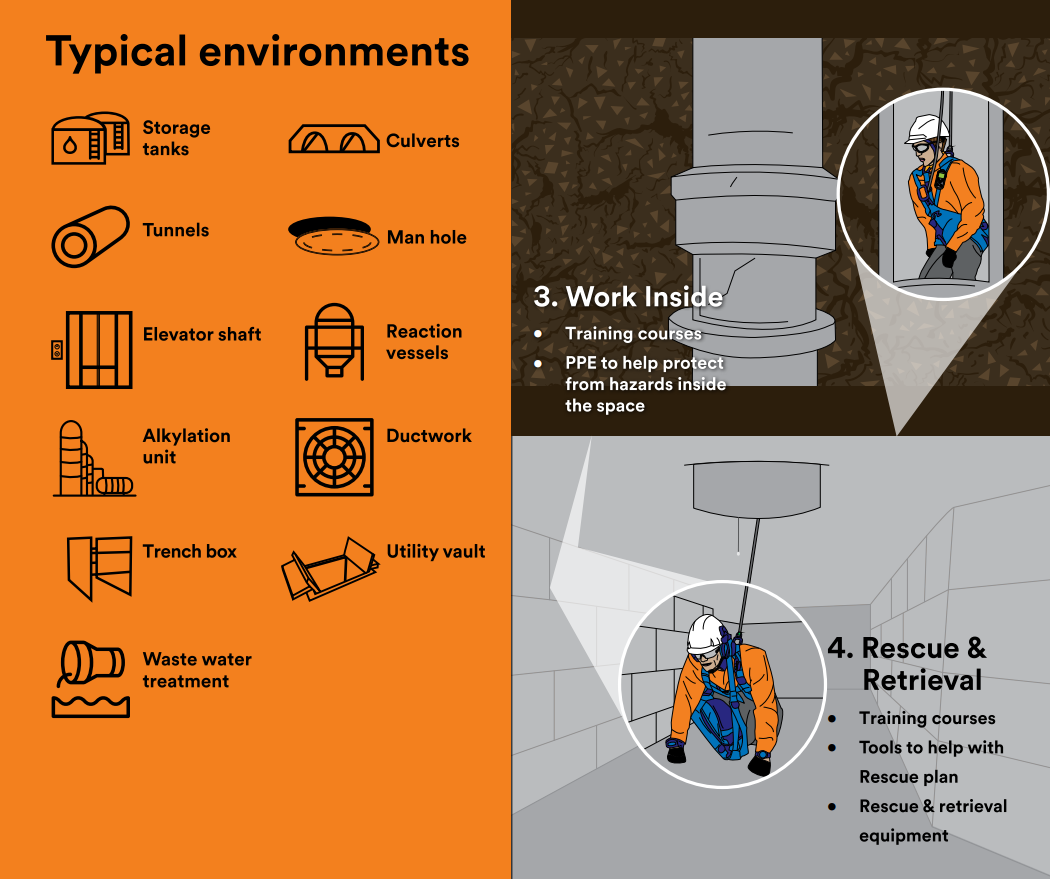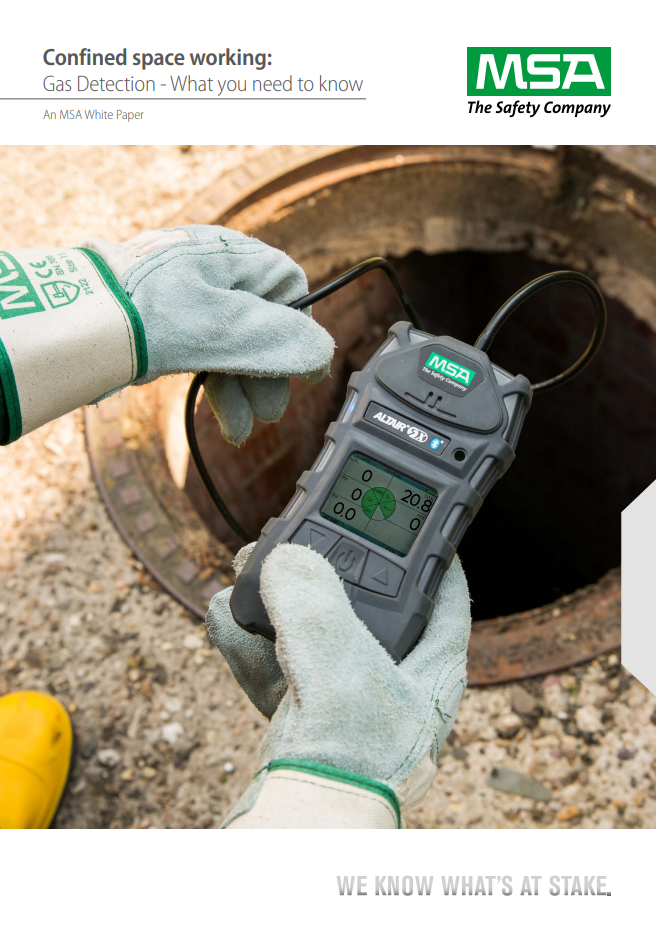.png)
The Four Elements to Successfully Manage Your Confined Spaces
Confined spaces can be complicated and anyone, in any industry, can be exposed to working in and around them.
Confined spaces come in different sizes, in different locations of a facility or job site, and there may be different hazards in each one. There are also many different standard, regulations and company policies that may apply. While complicated, there are some best practices that will help you work safely in and around confined spaces.
Handling confined space entrances and exits, and while working in these areas, should always include:
- A site evaluation
- Identification of proper safety equipment and other required tools
- A trained rescue team that has developed a pre-planning program
- Certified training that involves practice and hands-on experience for all parties who will work in and around a confined space
There are many people involved in planning for and managing confined spaces, accessing and working inside confined spaces, and responsible for any rescue retrieval that may be needed. A confined space supervisor will want to confirm that contractors have had certified training, that all parties understand the hazards and what communication is needed inside the space as well as who will be performing rescue activities. The supervisor may also be the person responsible for controlling the entry (or identifying who will be) and supplying the necessary equipment. If you are responsible for many types of confined spaces it may be helpful for you to walk through each of the major elements, which may be categorised as follows:
- Plan - everything you need before you enter
- Access - what you need to access
- Work inside - communication, communication, communication
- Rescue retrieval - be prepared
Let's break these down a bit more.
Planning for Your Confined Spaces
Every time you enter a confined space you should complete as assessment. This includes a risk and hazard assessment of the space, an assessment of the people working in and around the space and the level of knowledge they have about confined spaces, as well as an assessment of the personal protective equipment you need and the inventory you have available. The degree of supervision that will be needed will be based on these findings. If you don't have a Confined Space Competent Person or anyone who strictly manages your confined spaces you may need a third-party to complete a site assessment to help answer these questions.
What's the difference between a risk assessment and a hazard assessment?
Risk assessment - This involves identifying and understanding the environment in and around the confined space, including entry location and size of the entry as well as if there are any lockout points and possible sources of energy or chemicals. These things are consistent and very rarely change.
Hazard assessment - This is conducted to assess conditions workers are being exposed to that may present a danger, such as unsafe levels of gas requiring respiratory protection or loud noises requiring hearing protection. The conditions often change and therefore, this assessment should be constantly updated.
What type of training and certification do the workers need?
Workers must have adequate training and experience in the work involved to be competent to function safely in the confined space. Training required must be appropriate to the task, and to the individuals' roles and responsibilities, so that work can be carried out safely. Where the risk assessment indicates that properly training individuals can work for periods without supervisions you should check that they are able to follow the established safe system of work and that they have been provided with adequate information and instruction about the work to be done.
What PPE do you need?
Through the risk assessment and hazard assessment, and working through the hierarchy of controls, you should know what remaining hazards will require PPE protection. Blackwoods has a wide range of PPE equipment that is compatible when working within confined spaces.
Accessing Confined Spaces
Prior to entry, the atmosphere within a confined space should be tested to check the oxygen concentration and to determine the presence of hazardous fumes, gases and vapours as well as respective levels of these potential hazards. Also, if not already addressed, you should also ensure you have the proper equipment for access such as a tripod or a side entry system.
Testing
You must carry out testing that the atmosphere in the confined space might be contaminated or to any extent unsafe to breathe. It should always be tested as a legal requirement.
Equipment to access
The various types of confined spaces may all have different access points - side entry, descending from above or crawling up through an entry point - and require different access equipment.
Work Inside Confined Spaces
When working in the confined space, communication and monitoring should be a constant. Environmental elements can change unexpectedly, plus communicating with workers outside the confined space may become difficult.
Communication
An adequate communication system must be in place and should enable communication: (a) between those inside the confined space; (b) between those inside the confined space and those outside; and (c) to summon help in case of an emergency. Whatever system is used - voice, tugs on a rope, telecom devices - all message should be able to be communicated easily, rapidly and clearly between relevant people, especially if they may not be able to see one another.
Monitoring while working
In some cases, there may be a need to limit the time that professionals can work in in a confined space, for example where respiratory protection equipment is used, or under extreme conditions of temperature and humidity. This can also be the case when the confined space is so small that movement is severely restricted. For a large space and multiple entries, a log in or tally system may be necessary to check everyone in and out and to control the duration of time they are in the space.
Rescue retrieval
Death or injury in confined space incidents can and often do occur. Ill-conceived attempts to save others who have collapsed or ceased to respond usually follows from a lack of proactive planning and appropriate training or identification of a proper rescue plan.
Have a rescue plan
A rescue plan should be in place before any person attempts to enter or begins to work in a confined space. Speak up and don't enter a confined space without confirming there is a rescue plan in place outlining how to react should a situation arise where rescue action is needed.
Trained to rescue
Evaluate the needs of a rescue team and what training is required for the team (or individual) to perform a rescue operation, including what additional PPE they may need to help someone out of a dire situation.
There is a lot to consider when managing and working in and around confined spaces.
Confined Space - Plan and Rescue
Confined spaces present some of the most challenging environments for any health and safety professionals. From potentially toxic atmosphere, to physically hazardous conditions such as extreme temperatures, unstable materials, or the potential for falls, confined spaces often present unseen challenges. Creating and maintaining a safe jobsite with Confined Spaces depends on having correct, current information.












